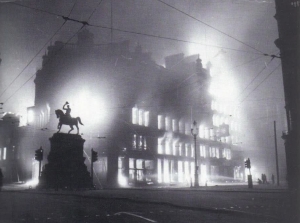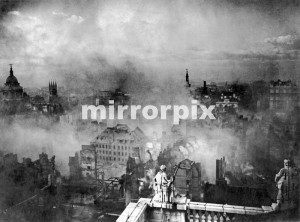Perhaps it is sufficient comment about the effect they had on him that my father very rarely spoke about three explosions which had such a huge impact on his early life in London during World War Two.
Derek James Glanvill was born at Thavie’s Inn, Holborn, in August 1929, and grew up there in a loving family with his father Percy and mother Ethel, and younger brother Roy. Percy was the warehouseman for a renowned books and engravings publisher, Virtue and Co., of 19-21 Thavie’s Inn, and the job provided spacious living accommodation on the premises, anciently one of the inns of court, where student lawyers trained; it was mentioned in Dickens’ ‘Bleak House’.
The Glanvills occupied the top floor of the old building, and a wealthy bookmaker and his family lived on the storey below. The bookmaker’s sons were slightly older than Derek and Roy, so the luxurious toys of which they grew bored were passed on and stored in a huge trunk in the corner of the large living room. Anything from train sets to air rifles, otherwise unaffordable to a warehouseman’s children, found their way up the stairs.
Like so many London youngsters the boys were evacuated soon after war broke out and were placed with various families in Croxley Green in Hertfordshire for around a year. On the night of 16 April 1941. Wren’s church, St Andrew, was hit by incendiaries and destroyed. Likewise the department Wallis & Co., celebrating its 115th birthday with a sale at the time.
The fire engulfed Thavie’s Inn too. Firemen fought the blaze all night and day, but to no avail. Percy and Ethel and their fortunately absent sons, aged 11 and 7, had lost virtually everything: possessions, home, childhood.
The brothers were brought back to London when newspapers carried details of a bombing raid near Croxley Green. Stomping up to Hertfordshire, Ethel announced that if they were going to be killed they would die with their parents.
The city was now very different, of course. Percy had found work and lodgings at Barclay’s Bank on Wardour Street, Soho, while the boys – whose school had closed, ending their education right there and then – treated the ravaged heartland as their playground, and shrapnel as collector’s items. Roy recalls the brothers and their friends coming across an unexploded incendiary. Rather than alert the authorities, they threw stones, and dropped it from heights in an attempt to see it explode. Luckily they were unsuccessful, or I might not be here to report the fact.
When not capering in bomb sites, Derek and Roy earned a few pence singing in the choir at St James’s church, Piccadilly. It was after a service around 11.15 on Sunday 18 June 1944 that the boys set out towards the Palace of Westminster – their curiosity had been roused by the rumour a bomb had landed there.
Regular explosives were not the chief concern by then. Hitler’s long-rumoured ‘pilotless aircraft’, the V1, was terrorising the capital. As they reached the Cenotaph on Whitehall they heard the uniquely gut-wrenching drone of an approaching flying bomb. Worse, the distinctive pulse of the engine stopped – at which point, they knew, the doodle bug began its deadly descent.
Looking up, they could see the flying bomb was headed straight for them. The only other person in the vicinity, a man across the street, also stopped in his tracks. Unlike in the films, none of them dived for cover, they just froze and awaited their fate. To their enormous relief the silent death passed just over their heads. They heard the explosion as it landed seconds later but didn’t consider the consequences too much. Until the next day, that is, when they heard ‘their’ doodle bug had hit the Guards’ Chapel at Wellington Barracks on Birdcage Walk during morning worship.
One hundred and twenty-one soldiers and civilians were killed in the carnage, and 141 injured. It was the most serious flying bomb incident of the entire war. Perhaps this was why my father, a regular gambler, always considered himself lucky.
At 14, schooling out of the question, Derek found work with an estate agent at Cavendish Square. He had already been through experiences few youngsters should. That was about to become far worse.
Late in the morning on Friday 30 June 1944 a V1 landed at the junction of Howland Street and Tottenham Court Road. Again intrigued, my father took off on his bicycle during the lunch break to view the damage. What he witnessed affected him so deeply he raced home to Wardour Street in distress and was violently sick. The images branded on his memory that day returned to him throughout his life.
Remember the impact of the bus bomb at 7/7 and imagine the damage a high-velocity explosive could do on a busy shopping street with traffic passing by. My father did not have to. He occasionally shared the most stunning of those recollections of what he witnessed with me:
‘A bus, still packed with people sitting in all the seats, but all the glass blown out and all the skin blown off their faces.’
Civil defence warden Charles Newbery, in his largely unemotional WWII account, ‘Wartime St Pancras’, describes ‘the doodle demolishing a café, wrecking two motorbuses, badly damaging a public house, a bank, many shops and workshops, and making a number of homes on Howland Street uninhabitable.’
When staff from nearby University College Hospital arrived on the scene they were confronted with a scene that was, Newbery relates, ‘indescribable – dead and injured all over the place, as well as the two buses, now only skeleton vehicles; a motor vehicle was blown off the road into the basements of some houses demolished after the Blitz in 1941.’
Even now exact casualty figures are difficult to discern. Newbery collates those from Howland Street with a less destructive V1 blast on Whitfield Street on 19 June and records: 82 dead, 196 seriously injured and 376 slightly injured.
Among those killed, it eventually emerged, was Sir Percy Alden, the Radical MP for Tottenham. Analysis of the home addresses of 44 of the dead – in Finchley, Hornsey, Holloway Road, Islington, Caledonian Road, Camden, Kensington Chelsea – suggests at least one of the buses may have been a no.14. Its ‘ghost‘ route, the 91, is one I use regularly; one of the victims, Herbert Bradford, lived in a house in Hornsey that I pass virtually every day.
It is easier for me to connect with those details than it was to gain an insight into how those three devastating wartime events shaped my innocent young father’s life. And he was one of so many who had their own similar moments or worse personal losses.
After the first V1 fell, the North London Press front page thundered: ‘The German “secret weapon” is no longer a secret. It is just another mistake of Hitler and his Huns, who hoped the break the unbreakable – the staunch morale of the Britishers. The flying bombs have destroyed some homes but it has not shattered the courage of the homeless.’
Not courage, perhaps, but something, certainly, was shattered.



